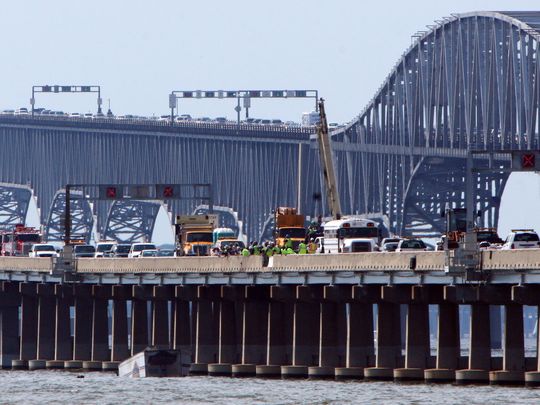What is it about bridges and the thought of falling off them that is so terrifying?
Last week a vehicle involved in a collision on Interstate 275 plunged off the Combs-Hehl Bridge into the Ohio River. Authorities have yet to recover the vehicle, the driver and any passengers due to river conditions. The frightening incident may awaken existing or new fears.
How often does this happen?
Probably not as much as you think, although it's hard to say. Each such incident is dramatic, often deadly and bound to get a lot of media attention, thus cementing it in the public consciousness as a real and perhaps common danger.
The National Transportation Safety Board tracks vehicle fatalities but doesn't make clear which happen from motorists falling off of bridges into water. The Centers for Disease Control and Prevention tracks drowning deaths, but its data available online don't say which drownings happened in vehicles, or after vehicles fell off bridges.
However, according to University of Manitoba researcher Gordon Giesbrecht, about 1 percent of all U.S. vehicle fatalities in 1999, or 350 deaths, were caused by drowning. Such deaths would include any event where a car is submerged, so off-bridge deaths in water are likely a smaller number.
Why am I so frightened by this?
You are not alone in your fears. Bridges scare a lot of people all by themselves. There's even a term for it: Gephyrophobia (pronounced "jeff-FIRE-ra-fo-bee-yah"), a word combining the Greek words for "bridges" and "fear."
Gephyrophobia is a common problem in areas with long bridges. A 2014 piece in USA TODAY found several long spans that are served by bridge driving assistance programs, including shuttle services. Mix fear of bridges with the fear of heights, falling and water, and you have a potent stew for anxiety.
Popular culture doesn't help downplay this fear. In movies and television shows, vehicles commonly drive off cliffs and bridges into water and land, ending the lives of their occupants. Think the ending of the 1991 movie "Thelma and Louise" or twice so far in the TV show "Vampire Diaries", among many others. Such epic demises are more than just dramatic fodder. They provide a convenient way to end a character's life without showing a lot of blood or gore, which could bump up a film or TV show's industry rating and thus limit its potential audience.
This and similar techniques aren't new to Hollywood. Quicksand, for example, was a common bloodless deathtrap for movie and television characters. A 2010 article in the online magazine Slate found quicksand remains a source of fear for many who grew up in 1950s through about 1980, although much less so for following generations as writers and producers dismissed quicksand demises as hokey.
Why is this nightmare fuel?
It just is. Dreaming about falling off a bridge checks off many boxes common for nightmare sufferers, according to a 2014 summary of dream content studies by two University of Montreal researchers and published by the journal Sleep. Falling, fear, death, danger and a risk of harm are common parts of many nightmares, they found.
The fall-off-bridge nightmare is common enough that sufferers have penned letters to so-called dream experts, asking why they're cursed by this particular bad dream. The typical response: Bridges indicate life transitions or goals, and dreaming of falling off a bridge indicates uncertainty about success in the transition or goal.
Take such interpretations with a grain of salt, though. In one 2002 case, in the Oklahoma City Oklahoman's Ask the Sandman column, the answer was provided by an unnamed "expert at the Oklahoma City School of Metaphysics."
So if I do fall into water in a car, what should I do?
You can survive if your vehicle plunges into water. Research proves it. However, it's important to ditch some myths. There is a lot of confusion about what to do if your call falls into water, as Giesbrecht reported in a 2006 research paper.
"Approximately half feel that they should stay in the vehicle while it fills with water or even until it sinks to the bottom," he said, assuming you can take a heroic final deep breath before making a "flawless exit."
This approach works in movies and television shows, but it's not a realistic exit plan, as the Discovery Channel show "Mythbusters" indicated in 2010. You might not know how deep the car will sink, or at what angle it will land, and you'll have to remain unnaturally calm.
Giesbrecht and fellow researcher Gerren McDonald conducted a series of trials to determine the best way to escape a sinking vehicle in several scenarios. Ignore calling 911, they determined, and keep this mantra in mind: seat belts, windows, children, out.
Seatbelts: Unfasten your seat belt as quickly as possible after impact with the water to allow you freedom of movement.
Windows: Get your windows open. Electronically controlled windows may fail quickly due to the water, so prioritize dropping all windows if possible. If the window motors stop working, break the glass with either an inexpensive escape hammer or any sturdy and sharp metal object. Focus on the side windows, not the windshield, which is much harder to break. Ignore the doors. They'll get harder to open as the vehicle sinks.
Children: Get them released from their restraints and close to an adult who can help.
Out: First push children out the window into the water, then follow immediately.


